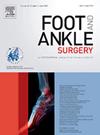在评估进行性塌足畸形的传统 X 光片时整合负重 CT 结果。
IF 1.9
3区 医学
Q2 ORTHOPEDICS
引用次数: 0
摘要
背景:进行性塌足畸形(PCFD)的治疗仍然具有挑战性。手术计划取决于畸形的数量和复杂程度,这就需要通过精确成像进行准确区分。负重 CT(WBCT)成像增强了对 PCFD 的三维(3D)评估。然而,目前仍不清楚 WBCT 上 PCFD 的发现与传统负重 X 光片的评估有何关联。因此,我们的目的是:(1) 将特定的 X 射线测量结果与相应的 WBCT 测量结果进行比较;(2) 评估相关 X 射线测量结果的可靠性;(3) 研究 X 射线测量结果能否推断出通过 WBCT 确定的距下关节区域的骨性撞击:方法: 在标准化负重X光片(手动)和WBCT数据集(自动生成)上评估了两种临床公认的测量方法:(1)距骨-桡骨重叠(TCO,毫米);(2)距骨-舟骨覆盖(TNC,°)。除测量结果外,WBCT 还采用三项标准评估距下关节区域的骨性撞击情况,并在评分者之间和评分者内部进行比较:(1) 关节阻塞;(2) 囊肿形成;(3) 继发性不稳定迹象。需要满足其中两个标准才能确定为距骨下撞击:虽然X光和WBCT的测量结果在TCO方面没有明显差异,但在TNC方面却有明显差异。X 射线测量和 WBCT 测量的观察者之间和观察者内部的可靠性都很好,类内相关系数大于 0.9。TCO 的平均测量偏差(X 光和 WBCT 之间)为 0.2 毫米,TNC 为-22 度。评估患者距骨下不稳的评分者间和评分者内可靠性的科恩卡帕(Cohen's Kappa)大于 0.9。如果X光片上的TCO>15毫米或TNC>25度,则推断出距骨下撞击的概率≥0.85:结论:通过传统X光片(TCO/TNC)或WBCT(骨性踝关节下撞击)可以可靠地评估所检查的成像参数。在没有 WBCT 的情况下,X 射线评估的 TCO 和 TNC 可作为骨性窦股撞击的预测指标。这一发现在评估 PCFD 患者时起着关键作用,有助于在保留关节的干预措施(如截骨术)和牺牲关节的手术(如复位融合术)之间进行手术决策:证据等级:IV级,观察性研究。本文章由计算机程序翻译,如有差异,请以英文原文为准。
Integrating weightbearing CT findings into evaluation of conventional radiographs in progressive collapsing foot deformity
Background
Progressive collapsing foot deformity (PCFD) remains challenging to treat. Surgical planning depends on the amount and complexity of the deformity, which requires accurate differentiation through precise imaging. Weightbearing CT (WBCT) imaging has enhanced the three-dimensional (3D) assessment of PCFD. However, it remains unclear how PCFD findings on WBCT are related to the evaluation of conventional weightbearing radiographs. Therefore, we aimed to (1) compare specific X-ray measurements to corresponding WBCT measurements; (2) evaluate the reliability of X-ray measurements of interest; and (3) investigate whether X-ray measurements can infer osseous impingement in the subtalar joint region identified through WBCT.
Methods
Two clinically established measurements were assessed on standardized weightbearing radiographs (manually) as well as on the WBCT datasets (auto-generated): (1) talo-calcaneal overlap (TCO, mm) and (2) talo-navicular coverage (TNC, °). In addition to the measurements, osseous impingement in the subtalar joint region was assessed on WBCT using three criteria, compared both inter- and intra-rater: (1) joint obliteration; (2) cyst formation; and (3) signs of secondary instability. Two of the criteria needed to be fulfilled to confirm subtalar impingement.
Results
While no significant difference between X-ray and WBCT measurements was evident for TCO, significant differences were found for TNC. Inter- and intra-observer reliability was with an intraclass correlation coefficient > 0.9 excellent for both measurements on X-rays. The mean bias of measurement (between X-ray and WBCT) was 0.2 mm for TCO and −22 degrees for TNC. Cohen’s Kappa for inter- and intra-rater reliability to assess patients for subtalar instability was > 0.9. The probability to infer subtalar impingement was ≥ 0.85 if TCO was > 15 mm or TNC was > 25 degrees on X-ray.
Conclusion
The examined imaging parameters are reliably assessable through conventional radiographs (TCO/TNC) or WBCT (osseous subtalar impingement). In situations where WBCT is unavailable, X-ray-assessed TCO and TNC can serve as predictors for osseous sinus tarsi impingement. This finding plays a pivotal role in evaluating PCFD patients, aiding in the surgical decision-making process between joint-preserving interventions (e.g., osteotomies) and joint-sacrificing procedures (e.g., realignment fusion).
Level of Evidence
Level IV, observational study
求助全文
通过发布文献求助,成功后即可免费获取论文全文。
去求助
来源期刊

Foot and Ankle Surgery
ORTHOPEDICS-
CiteScore
4.60
自引率
16.00%
发文量
202
期刊介绍:
Foot and Ankle Surgery is essential reading for everyone interested in the foot and ankle and its disorders. The approach is broad and includes all aspects of the subject from basic science to clinical management. Problems of both children and adults are included, as is trauma and chronic disease. Foot and Ankle Surgery is the official journal of European Foot and Ankle Society.
The aims of this journal are to promote the art and science of ankle and foot surgery, to publish peer-reviewed research articles, to provide regular reviews by acknowledged experts on common problems, and to provide a forum for discussion with letters to the Editors. Reviews of books are also published. Papers are invited for possible publication in Foot and Ankle Surgery on the understanding that the material has not been published elsewhere or accepted for publication in another journal and does not infringe prior copyright.
 求助内容:
求助内容: 应助结果提醒方式:
应助结果提醒方式:


